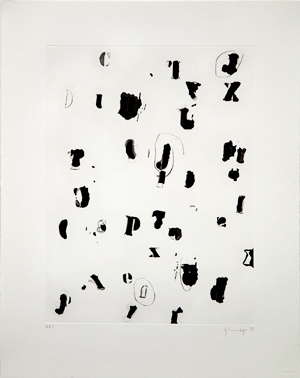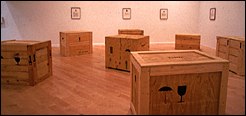|

DEBRIS FIELD I, 2015
Aquatint with sugar lift, drypoint and scraper
21.5 x 17 inches
Edition of 35
SOLD
Brooklyn-based
artist Glenn Ligon was a Walker artist-in-residence as part of an
exciting initiative funded by the Pew Charitable Trusts-Artists and
Communities at the Crossroads-which will introduced contemporary
artists to Twin Cities communities.
Ligon is one of today's most prolific artists. Through works that
incorporate the historical with the present and the socially inflected
with the aesthetically complex, he is an artist who resists easy
categorization. He has drawn from sources as varied as Andy Warhol,
Jasper Johns, Adrian Piper, and Richard Pryor, and from practices
ranging from Conceptual, Pop, and Appropriation Art to Minimalism. Best
known as a painter who uses language as a device for both image and
communication, Ligon addresses issues of identity and politics through
quotations from culturally charged material. His word paintings excerpt
evocative texts by writers such as James Baldwin, Ralph Ellison, and
Zora Neale Hurston. He has said of his work that he wants to "make
language into a physical thing, something that has real weight and
force to it." The weight of language is further investigated in his
print series such as Runaways and Narratives, which bring the
racialized past into the present through Ligon's manipulations and
updating of 19th-century runaway slave posters and slave narratives,
respectively.
Ligon has continued to work with found texts and images such as those
from the 1995 Million Man March. He is also exploring the luminescence
of black coal dust as a metaphorically charged material in paintings
and drawings. In all his work, Ligon surveys America's cultural
legacies and situates them in contemporary life.
- text from Walker Art Center
The
Detroit Institute of Arts presented an installation by New York artist
Glenn Ligon, who is widely recognized as one of the most thoughtful and
accomplished young American artsts, and the installation, Glenn
Ligon: To Disembark, is adapted from his 1994 solo exhibition
at the Hirshhorn Museum and Sculpture Garden in Washington D.C.

The installation explores the relationships between history, race and
identity. The variety of media Ligon uses includes wooden packing
crates, recalling the story of a slave who had himself shipped from
Richmond, Virginia to freedom in Philadelphia in 1849; lithographs
imitating 19th-century advertisements for the return of escaped slaves,
each of which names and describes Ligon himself; and etchings, also
referring to the artist, which mimic the frontispieces of 19th-century
narratives in which former slaves recounted their lives under slavery
and stories of their escapes.
"[I
WANT TO] MAKE LANGUAGE INTO A PHYSICAL THING,
SOMETHING THAT HAS REAL WEIGHT AND FORCE TO IT."
-GLENN LIGON
|